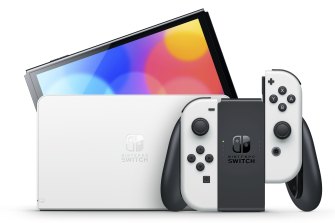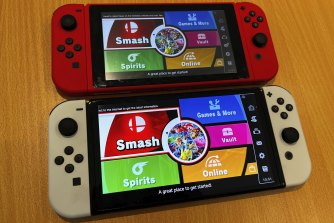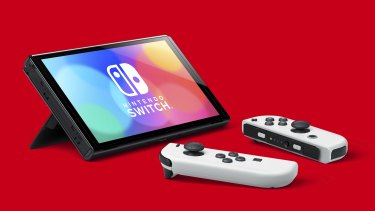Nintendo refines its revolutionary Switch console
After four-and-a-half years, Nintendo’s Switch console has proven wildly successful thanks to its flexibility and incredible library of games. This Friday sees the launch of a new model of the machine and, while it isn’t the massive advancement over the 2017 hardware some may be hoping for, it’s a significantly nicer machine that should keep the platform from showing its age a few years longer.
If you’re not familiar, the Switch is a hybrid console you can play at home on your big TV, or on the go like a Game Boy, thanks to clever controllers that can attach to the sides of the tablet-like system or attach to a grip to become a traditional pad. It sports a big touchscreen, many options for couch, wireless and online multiplayer, advanced rumble vibration and a stand so you can play on a plane or at a kitchen table.

The Nintendo Switch (OLED Model) comes in white instead of grey, but there’s also a red and blue neon version with a black dock.
It’s also become the defacto home for Nintendo’s blockbuster games as well as all manner of retro and indie fare, resulting in around 90 million units sold, on track to become Nintendo’s best-selling home console of all time next year. With its primary selling point being a new more advanced screen, the creatively named Nintendo Switch (OLED Model) does everything the older Switch does, just with a bit more refinement.
The OLED screen is an immediately obvious upgrade from the second you turn it on. At 7-inches it’s only around 2 centimetres larger on the diagonal than the LCD screen on the old model, but because the black bezels around the sides are greatly reduced it appears much bigger and more immersive. It’s also more colourful, brighter, clearer and nicer to touch than the original â€" which combined with new glossy edges and glittery textured back make for a more premium feeling unit â€" but minimal changes to the overall footprint means accessories work for new and old Switches.

The OLED Switch, below, has a bigger and brighter screen with incredible contrast.Credit:Tim Biggs
An OLED means self-lit pixels with no backlight, making for perfect blacks even when you max out the brightness. Making things too bright on the original model tended to spoil the colour, but here you get beautiful contrast and an incredibly bold look that will outperform a lot of TVs. I turned off the automatic brightness so I could stay near max the whole time. Of course the resolution of the screen remains under Full HD at 720p, but at this size that’s still very sharp.
Whether intentional or not, Nintendo’s Metroid Dread (out on the same day as the OLED Switch) offers some excellent examples of the leap in display technology here. Many dark scenes are lit only by the neon green of bounty hunter Samus Aran’s glowing visor and suit details, as well as ambient reflections and the hazy blue mist of background research equipment, and it looks stunning on the new screen. Any game with a lot of colour, contrast and smooth fast-moving action (think Mario Kart, or Super Smash Bros) looks much improved.

A redesigned stand makes it possible to set the console up much more stably.
But it isn’t all about the screen, as small tweaks and changes across the board make the new Switch a notably more comfortable machine, especially in handheld mode.
Around the back the original’s often-useless stand has been replaced by one that runs the width of the system and is joined with stiff hinges, letting you prop it up stably at any angle for tabletop play.
Elsewhere the top exhaust is covered by thicker plastic with tighter ventilation that looks much less likely to crack and fall apart over time like the plastic on my launch Switch has, and the speakers now fire down rather than out the back making for louder and clearer sound.
Internally the new Switch is almost identical to the old, which is great for compatibility (every game works just as well on all models) but means you won’t get any performance improvements. Battery life is just as good as the 2019 Switch refresh, at 4.5 to 9 hours of constant gameplay. One improvement is a doubling of internal storage from 32GB to 64GB, meaning you should get at least 10 games on there before you need a microSD card to expand your space.
If you play mostly connected to the TV, there isn’t a lot here in the way of improvements. The dock looks nicer and more rounded, with a new design that makes it easier to access cables and should be less likely to scratch your Switch’s display. And it now has an Ethernet port instead of a third USB, allowing for a much more stable internet connection when you’re on the big screen. But you get the same gameplay experience, topping out at 1080p.
All up this feels like a model destined to supplant the original Switch, fixing some design flaws while greatly modernising the presentation of handheld mode. Existing owners will have no burning need to upgrade, especially since the OLED model goes for $539. But it’s certainly an improvement, and after a week with this new system the screen on my old Switch already looks small, weak and washed out by comparison.
Get news and reviews on technology, gadgets and gaming in our Technology newsletter every Friday. Sign up here.
Tim Biggs is the editor of The Age and Sydney Morning Herald technology sections.Connect via Twitter or email.